Electrolux QB7700, QB5500, QB3300, QB1300, QB2800 User Manual
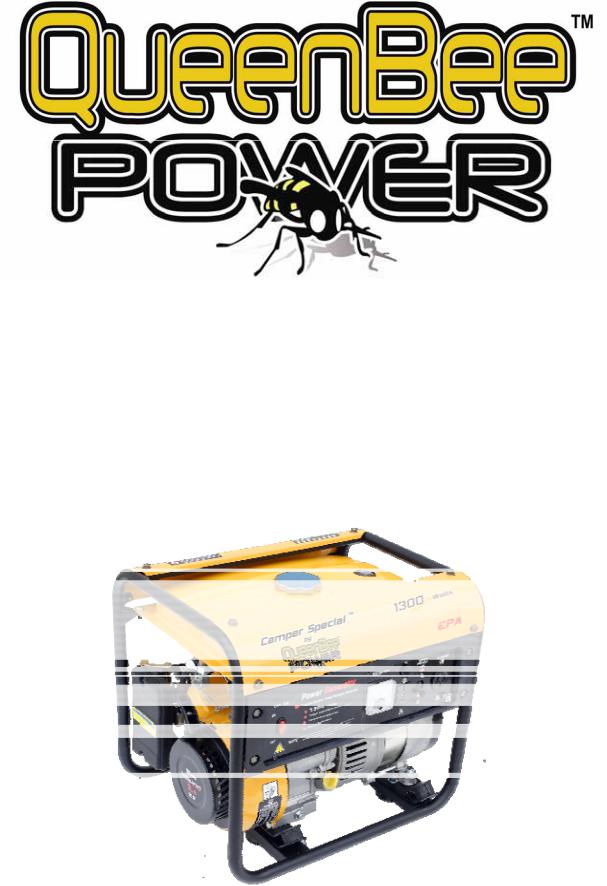
Gasoline Generators
Operator Manual
Thank you for purchasing our generator. We want to help you get the best results from your new generator and to operate it safely. This manual contains the information on how to do that; please read it carefully. This owner’s manual describes the operation and maintenance of the Generator. All information in this publication is based on the latest product information available at the time of printing.
We reserve the right to make changes at any time without notice and without incurring any obligation.
No part of this publication may be reproduced without written permission. This manual should be considered a permanent part of the generator and should remain with it even if ownership changes.
SAFETY
Your safety and the safety of others are very important. We have provided important safety messages in this manual and on the generator. Please read these messages carefully. A safety message alerts you to potential hazards that could hurt you or others. Each safety message is preceded by a safety alert symbol and one of three words: DANGER, WARNING, or CAUTION.
DANGER - You WILL be KILLED or SERIOUSLY HURT if you don’t follow instructions. WARNING - You CAN be KILLED or SERIOUSLY HURT if you don’t follow instructions. CAUTION - You CAN be HURT if you don’t follow instructions.
Each message tells you what the hazard is, what can happen, and what you can do to avoid or reduce injury.
Damage Prevention Messages
You will also see other important messages that are preceded by the word NOTICE. This word means:
NOTICE - Your generator or other property could be damaged if you don’t follow instructions.
The purpose of these messages is to help prevent damage to your generator, other property, or the environment.
DANGER - CARBON MONOXIDE HAZARDS
•Always use generators outdoors, away from doors, windows and vents.
•NEVER use generators in homes, garages, basements, crawl spaces, or other enclosed or partially enclosed areas, even with ventilation.
•Follow manufacturer’s instructions.
•Install carbon monoxide (CO) alarms in your home, following manufacturer’s instructions. WARNING - ELECTRICAL HAZARDS:
•Keep the generator dry. Operate on a dry surface under an open, canopy-like structure.
•Dry your hands before touching the generator.
•Plug appliances directly into generator or use a heavy-duty outdoor-rated extension cord.
•NEVER plug the generator into a wall outlet. This practice, known as back feeding, can cause an electrocution risk to utility workers and others served by the same utility transformer.
•If necessary to connect generator to house wiring to power appliances, have a qualified electrician install appropriate equipment.
CAUTION - FIRE HAZARDS:
•Before refueling the generator, turn it off and let it cool. Fuel spilled on hot engine parts could ignite.
•Always store fuel outside of living areas in properly labeled, non-glass containers.
•Store fuel away from any fuel-burning appliance.
2
Table Of Contents |
|
SAFETY |
2 |
SAFETY LABEL LOCATION |
4 |
SAFETY INFORMATION |
5 |
Component Identification |
6 |
CONTROLS |
7 |
Engine Switch |
7 |
Recoil Starter |
7 |
Fuel Valve |
7 |
Choke Rod |
8 |
Circuit Breaker |
8 |
Ground Terminal |
8 |
Oil Alert System |
8 |
Pilot Lamp |
8 |
DC Terminals |
8 |
DC Circuit Protector |
9 |
GENERATOR USE |
9 |
Connections to a Building’s Electrical System |
9 |
Generator Ground Circuit |
9 |
AC Applications |
9 |
AC Operation |
10 |
DC Operation |
10 |
Disconnecting the battery cables |
11 |
PREOPERATION CHECK |
11 |
Engine Oil |
11 |
Fuel Recommendation |
12 |
STARTING THE ENGINE |
13 |
STOPPING THE ENGINE |
14 |
MAINTENANCE |
14 |
Maintenance Schedule |
15 |
Engine Oil Change |
15 |
Air Cleaner Service |
16 |
Fuel Sediment Cup Cleaning |
17 |
Spark Plug Service |
17 |
TRANSPORTING/STORAGE |
18 |
TROUBLESHOOTING |
20 |
TYPICAL WIRING DIAGRAM |
20 |
SPECIFICATIONS |
21 |
TYPICAL WATTAGES |
22 |
LIMITED WARRANTY |
25 |
3
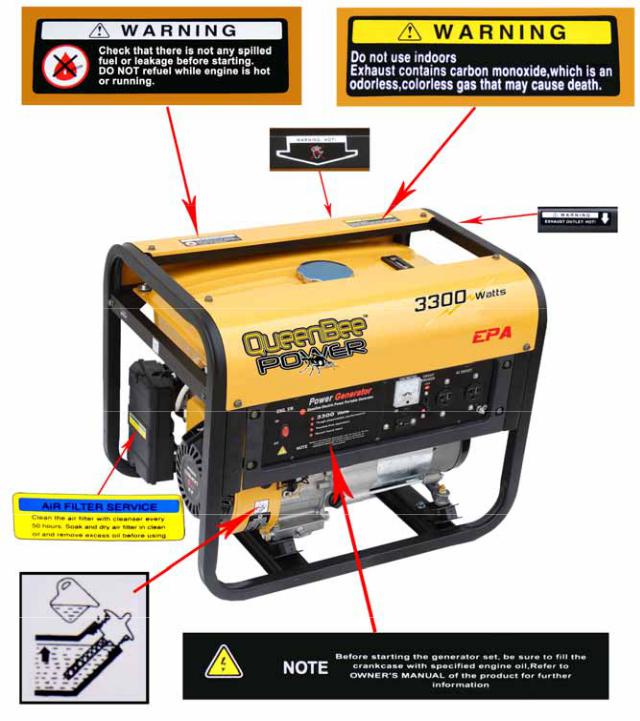
SAFETY LABEL LOCATION
These labels warn you of potential hazards that can cause serious injury. Read them carefully. If a label comes off or becomes hard to read, contact your generator dealer for a replacement.
4
WARNING!
Do not connect to a building’s electrical system unless a transfer switch has been installed by a qualified electrician. Using a generator or an electrical appliance in wet conditions such as rain or snow or near a pool or sprinkler system, or when your hands are wet, could result in electrocution. Keep the generator dry.
SAFETY INFORMATION
Generators are designed to give safe and dependable service if operated according to instructions.
Read and understand this owner’s manual before operating your generator. You can help prevent accidents by being familiar with your generator’s controls and by observing safe operating procedures.
Operator Responsibility
Know how to stop the generator quickly in case of emergency. (See Page 14)
Understand the use of all generator controls, output receptacles and connections.
Be sure that anyone who operates the generator receives proper instruction. Do not let children operate the generator.
Carbon Monoxide Hazards
Exhaust contains poisonous carbon monoxide, a colorless and odorless gas. Breathing exhaust can cause loss of consciousness and may lead to death. If you run the generator in an area that is confined, or even partially enclosed, the air you breathe could contain dangerous amounts of exhaust gas. To keep exhaust gas from building up, provide adequate ventilation.
Electric Shock Hazards
The generator produces enough electric power to cause a serious shock or electrocution if misused. Using a generator or electrical appliance in wet conditions, such as rain or snow, or near a pool or sprinkler system, or when your hands are wet, could result in electrocution. Keep the generator dry.
If the generator is stored outdoors, unprotected from the weather, check all electrical components on the control panel, before each use. Moisture or ice can cause a malfunction or short circuit in electrical components which could result in electrocution.
Do not connect to a building’s electrical system unless a transfer switch has been installed by a qualified electrician.
Fire and Burn Hazards
The exhaust system gets hot enough to ignite some materials.
•Keep the generator at least 1 meter (3 feet) away from buildings and other equipment during operation.
•Do not enclose the generator in any structure.
•Keep flammable materials away from the generator.
The muffler becomes very hot during operation and remains hot for a while after stopping the engine.
•Be careful not to touch the muffler while it is hot.
•Let the engine cool before storing the generator indoors.
Gasoline is extremely flammable and is explosive under certain conditions.
5
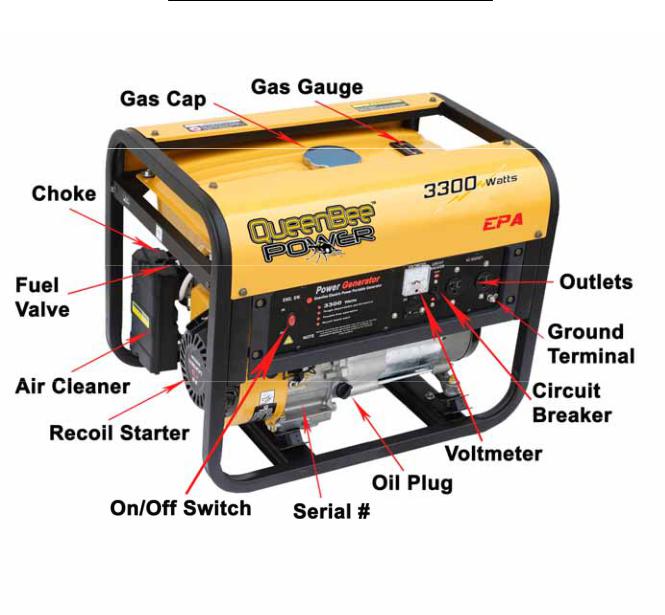
•Do not smoke or allow flames or sparks where the generator is refueled or where gasoline is stored.
•Refuel in a well-ventilated area with the engine stopped.
Fuel vapors are extremely flammable and may ignite after the engine has started. Make sure that any spilled fuel has been wiped up before starting the generator.
Record the engine serial number for your future reference. (See Page 6) Refer to this serial number when ordering parts, and when making technical requests.
Engine serial number:
6
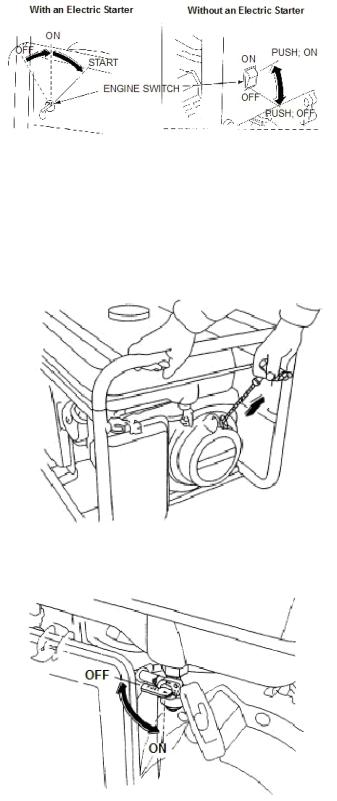
CONTROLS
Engine Switch
To start and stop the engine.
Switch position:
OFF: To Stop the engine. Key can be removed/inserted.
ON: To run the engine after starting.
START: To start the engine by turning the starter motor.
Return the key to the ON position once the engine has started. Do not use the starter for more than 5 seconds at a time. If the engine fails to start, release the switch and wait 10 seconds before operating the starter again.
Recoil Starter
To start the engine. Pull the starter grip lightly until resistance is felt. then pull briskly.
NOTICE
Do not allow the starter to snap
Back against the engine. Return it gently to prevent damage to the starter.
Fuel Valve
The fuel valve is located between the fuel tank and carburetor. When the valve lever is in the ON position, fuel is allowed to flow from the fuel tank to the carburetor. Be sure
to return the lever to OFF after stopping the engine.
7
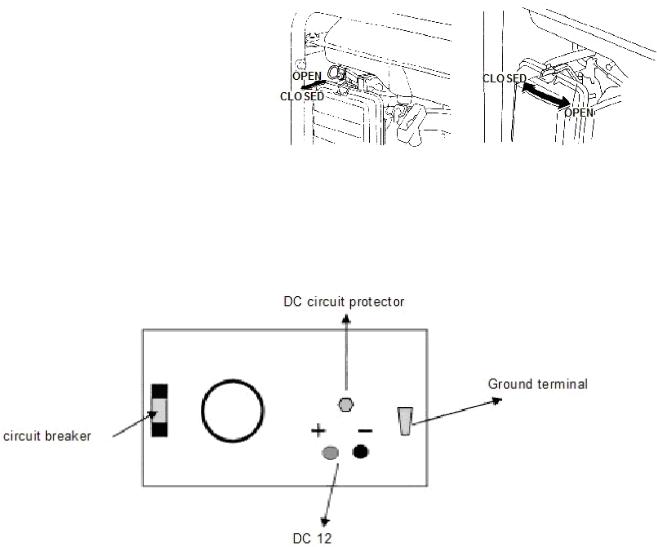
Choke Rod
The choke is used to provide an enriched fuel mixture when cold starting. The choke can be opened by moving the choke rod to the right and closed by moving the choke rod to the left.
Circuit Breaker
The circuit breaker will automatically switch OFF if there is a short circuit or a significant overload of the generator at the receptacle. lf the circuit breaker is switched OFF automatically, check that the appliance is working properly and does not exceed the rated load capacity of the circuit before switching the circuit breaker ON again.
Ground Terminal
The generator ground terminal is connected to the frame of the generator, on a metal non-current carrying part of the generator, and the ground terminals of each receptacle.
Oil Alert System
The Oil Alert system is designed to prevent engine damage caused by an insufficient amount of oil in the crankcase. Before the oil level in the crankcase can fall below a safe limit, the Oil Alert system will automatically shut down the engine (the engine switch will remain in the ON position). The QB1300 does not have this feature.
Pilot Lamp
The pilot lamp is illuminated when the generator is operating normally.
DC Terminals
The DC terminals may ONLY be used for charging 12 volt automotive type batteries. The terminals are colored red to identify the positive (+) terminal and black to identify the negative (-) terminal. The
8
